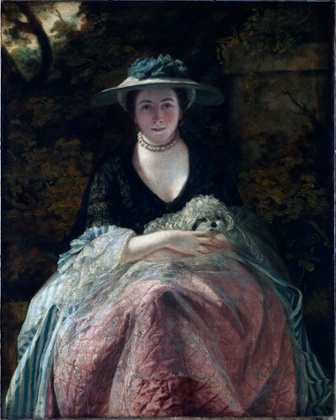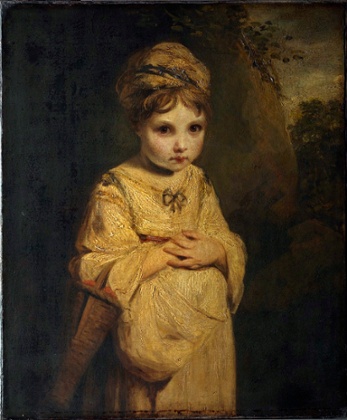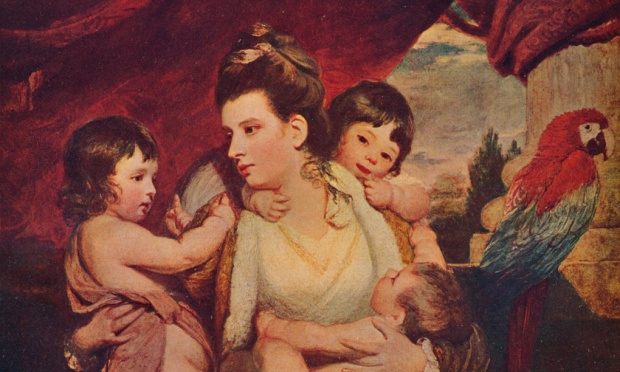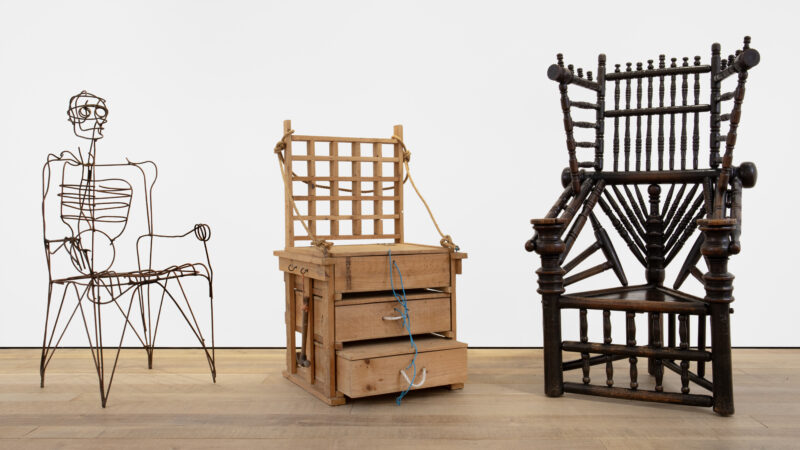In 1773 the successful portrait artist Joshua Reynolds painted the aristocratically maternal Lady Cockburn and her three young sons using the methods he preached in his lectures as first president of the Royal Academy.
Study the old masters, Reynolds instructed his students, for “the works of those who have stood the test of ages, have a claim to … respect and veneration to which no modern can pretend”.
In his portrait of Cockburn and her boys Reynolds practised what he preached. He structured his composition with quotations from masterpieces by Van Dyck and Velázquez. Yet Reynolds thought the picture still needed something – so he added a portrait of his huge pet parrot to its classical setting.
Nowadays Reynolds’ parrot is by far the most engaging part of this picture, which hangs in the National Gallery. The flamboyant red, blue and yellow bird lives in a way Cockburn does not.
If only Reynolds had followed his eccentric whims more often. If only he had painted parrots instead of posh people, and done so spontaneously instead of eruditely, he might be an artist the modern world could love.
Sir Joshua Reynolds, who was born in 1723 and died in 1792, was the most famous and honoured artist of his time, a figure so central to British art history that his statue still greets visitors to the Royal Academy. But modern eyes find his contemporaries infinitely more interesting. The scientific dramas of Joseph Wright of Derby, the intense, almost surreal animal portraits of George Stubbs, and the sensuality of Thomas Gainsborough make Reynolds look dull by comparison. The National Gallery has shoved Lady Cockburn over to the edge of its British gallery to make way for these artists.
But has Reynolds been misunderstood? Is he the victim of his own avant garde boldness? An exhibition opening on Thursday at the Wallace Collection in London shows he took risks – as he did by adding his parrot to a formal portrait – all the time. After examining his works in the National Gallery’s laboratories and comparing his technique with what people said about him in his lifetime, experts have concluded he has been done down.

“Contemporaries talk about him as this experimental painter,” said the exhibition’s co-curator, Mark Hallett. “He talks about his experiments in paint; he talks about his failures. He says his approach means there will be failures as well as successes.”
My ears pricked up at this, because if there’s one certain thing about Reynolds’ paintings it is their total inconsistency. Some of his portraits have faded, blueish-white faces or bubbly crusts, as if they have been boiled. Others look like they were phoned in. And some are majestic. The Wallace Collection owns a full range, from the weird and hideous The Strawberry Girl to his luminous portrait of Nelly O’Brien in sunlight that anticipates the impressionists by more than a century.
The Wallace Collection’s Reynolds research project, whose findings the new exhibition will make public, has established, through a battery of hi-tech analyses, exactly how experimental Reynolds was. He was constantly trying out new pigments and media, sometimes with bizarre results.
“He does use oil paint, in general, but he adds things to it,” said the project’s paintings conservator, Alex Gent. “Generally what he adds is mastic and resin, so the varnish is mixed into the paint. It’s partly to recreate the translucency of old master paintings.” Sometimes he even added wax to imitate the encaustic painters of ancient Rome. All these impurities led to his paint “cracking”, said Gent.
Even more eccentrically, Reynolds decided that British portraits looked too ruddy-faced, and to get a more subtle flesh tone he used red lake pigment. “But it fades,” Gent said.
So it was routine for Reynolds to have to restore faded portraits. No one seemed too bothered by it. Today the ghostly faces of his failed experiments haunt our galleries, like gothic monsters.

The image of Reynolds that emerges from the Wallace Collection’s exhibition is a kind of mad scientist, a would-be alchemist of art. It makes for a much more attractive personality than the man who handed down the rules of art in his lectures to the academy. Hallett observed that Reynolds could often speak in an official oratorical tone while, in his letters, he used a much more human one: “witty, playful, idiosyncratic.”
Yet does all this rescue Reynolds as an artist? For me, it does. Reynolds changed British art because he had such vast ambitions for it. When he became founding president of the Royal Academy in 1768 he really believed it could raise British art to the heights of the Renaissance. He was vindicated soon after his death when two of its students, John Constable and JMW Turner, took British painting into the stratosphere. As it happens, one of the research project’s discoveries is that Reynolds used Indian yellow decades before Turner.
Britain in the 1700s was bubbling with commerce, industry and science. The Enlightenment encouraged experiments, from Horace Walpole’s reinvention of the gothic style to Laurence Sterne’s self-deconstructing novel Tristram Shandy. Reynolds stood at the centre of this bold culture, and portrayed its leading lights with brilliant familiarity.
With this new idea of Reynolds in mind, his paintings in the National Portrait Gallery suddenly come alive. He captured the scientist Joseph Banks as a brilliant, passionate, perceptive character. His portrait of Samuel Johnson makes you feel the force of the great man of letters. He portrayed Walpole as a strange genius, and gave Sterne an almost demonic mask of a face.
These are great paintings. Reynolds is not remote or staid at all. He’s the portraitist of the Enlightenment, a daring artist who captured a daring age.
Joshua Reynolds: Experiments in Paint, Wallace Collection, 12 March to 7 June, admission free
guardian.co.uk © Guardian News & Media Limited 2010
Published via the Guardian News Feed plugin for WordPress.
 Detail from Lady Cockburn and her Three Eldest Sons, 1773, by Joshua Reynolds. Photograph: The Print Collector/Getty Images
Detail from Lady Cockburn and her Three Eldest Sons, 1773, by Joshua Reynolds. Photograph: The Print Collector/Getty Images






